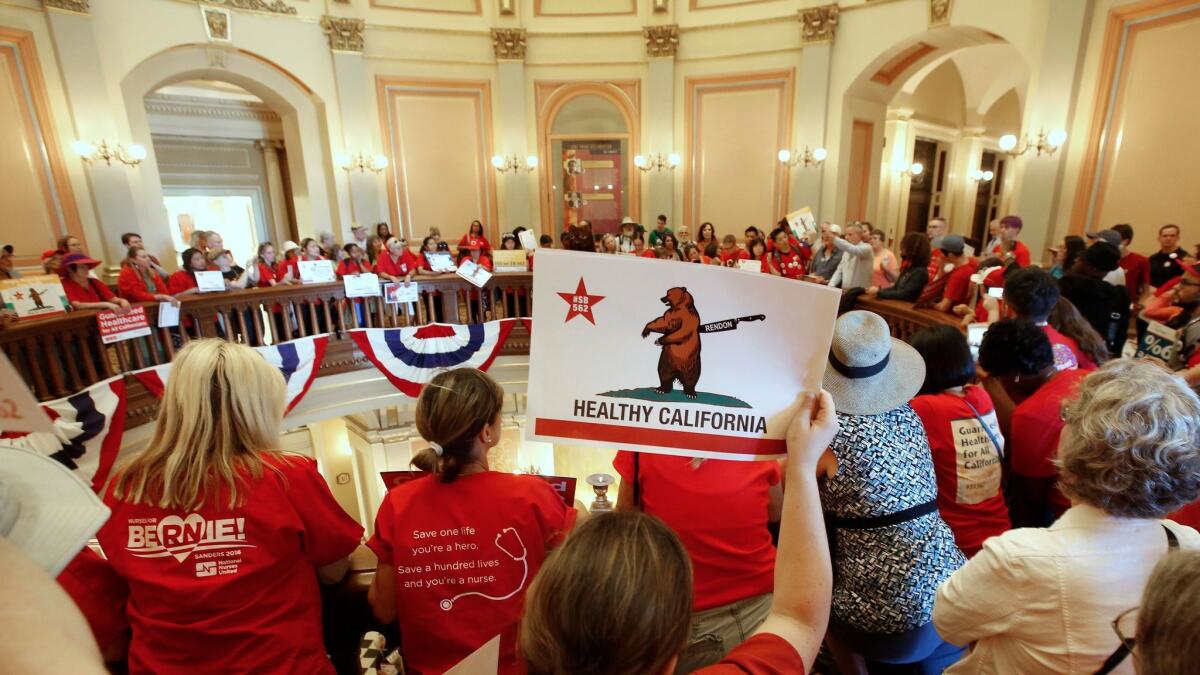Op-Ed: Single payer can’t happen in California. At least, not right away

Given the dismal state of healthcare reform in Washington, liberal Californians have rallied around the idea that the state should establish a single-payer program. Although in the future such a system would be workable and desirable, the reality is that at the moment a single-payer bill cannot pass. Fighting for one in the immediate term is a waste of time.
Financing, first of all, is a heavy lift. In addition to higher state taxes, California would need to channel Medicare and other federal healthcare funding into the single-payer system. Before it can do that, Congress must pass a waiver and the president must sign it — which isn’t going to happen while Donald Trump is in office.
The challenge of local political support is just as difficult to meet. Californians need to elect a governor who will sign the legislation. The current one will not do so. So-called “moderate” or “corporate” Democrats in the Assembly and state Senate who oppose single payer need to be persuaded that it is in their interest to vote for it. Millions of California voters with relatively good insurance coverage and those on Medicare are fearful of a radical change in their protections.
Another problem is that the most recent version of the single-payer bill mandates an “overnight” approach — it would put for-profit insurance companies out of business from one year to the next and force all existing public safety net programs to rapidly combine their administrative structures and processes. The prospect of such sudden change will encourage insurance companies to ramp up their already vehement and well-funded opposition. The bureaucratic complexities of the Medi-Cal program, moreover, put into doubt that California could effectively administer a single-payer program on such a short time frame.
Some activists propose placing a single-payer initiative on the next state ballot, but this would be catastrophic.
Overcoming these three difficulties will require advocates to develop broader, deeper and more diverse (in every sense of the word) coalitions, alliances and legislative relationships. It will also require convincing millions of skeptical California voters that state government can run an efficient health insurance system.
Meanwhile, at the national level, Democrats have the daunting task of winning back the House, Senate and the White House. But by 2020, California might just be ready for single payer — if advocates achieve a string of smaller but important legislative victories to build power.
Such steps might include: a state individual mandate; a state employer mandate that also covers part-time workers and their dependents; continued guaranteed coverage for children in the country illegally; giving the state insurance commissioner the power to regulate insurance premiums; setting a process to negotiate drug and medical device pricing; administrative reforms to streamline Medi-Cal so that there is less waste and better coordination and continuity of care; engaging the state’s tech sector to assist with such streamlining; advancing nonprofit delivery systems and moving away from fee-for-service practice; and opening up Medi-Cal to everyone, which would effectively create a state public option robust enough to compete on a level playing field against private insurers.
As to the problem of persuading “corporate” Democrats to support single payer, one strategy would be to run pro-single-payer candidates in key primaries. The resources of the entire state movement would be concentrated in these campaigns and a movement victory in even one such race would cause deep reflection and rethinking of positions.
Some activists propose placing a single-payer initiative on the next state ballot, but this would be catastrophic. There is no evidence that such an initiative could win in California. The preconditions for a ballot victory simply do not yet exist.
Proposition 61 on drug price controls was badly defeated despite a high-profile endorsement from Sen. Bernie Sanders (I-Vt.). The initiative to have the state insurance commissioner regulate premiums was also badly defeated. And then there’s the historic 1994 defeat of Proposition 186, which proposed establishing a single-payer system in California. That went down by a 3-to-1 margin. Insurance companies and Pharma would see a single-payer proposition as an existential threat and spend the money needed to crush yet another health reform initiative. So far, they’ve got a 1.000 batting average.
We do not need yet another devastating loss. Time, treasure and effort would be better spent winning the series of smaller victories that create the pathway to single payer. And in four years, a substantially stronger single-payer movement could successfully lobby a new Congress and president for federal waivers.
The fight over the role of government in medical care is not something new. It goes back to the founding of our republic, with passage of the Merchant Marine Act in 1798. More than a century ago, Theodore Roosevelt called for a system of national health insurance. Single-payer advocates have been working for decades. They’ll have to work a few years more.
Steve Tarzynski is a physician and president of California Physicians Alliance.
Follow the Opinion section on Twitter @latimesopinion or Facebook
More to Read
A cure for the common opinion
Get thought-provoking perspectives with our weekly newsletter.
You may occasionally receive promotional content from the Los Angeles Times.








